- Jewelry
- Inspiration
- Good Deals
- Paintings
- About
- Contact
JEWELRY
- Anklet
- Bracelets
- Brooches
- Cufflinks
- Earrings
- Pendants & Necklaces
- Rings
- Draw your jewelry
- GOOD DEALS
- How to clean your jewel
- Metal we used
INSPIRATION
- Our imagination
- Birthstones
- Druids and druidesses
- Flower meanings
- History, archeology jewelry
- Japanese symbols
- Lithotherapy and stone choice
- Illumination jewelry
- Maya calendar jewelry
- Stone color symbolism
- Stones Catalogue
- Searches a theme on the site
ABOUT
The Symbolism of Stone Colors

Just as flowers carry a message, the colors we wear speak about us. They reflect our personality, emotions, and state of mind. Each color has a profound symbolic meaning, capable of influencing our emotions, thoughts, and even our actions. For millennia, civilizations have associated colors with specific energies, viewing them as subtle communication channels between the individual and their environment.
We are naturally drawn to a spectrum of colors that resonates with our inner state. This choice is not random; it is often dictated by our unconscious, which seeks chromatic harmonies capable of nourishing our emotional and psychological needs. By creating a piece of jewelry from a color that speaks to us, we not only express our personality but also project an energy towards others, thereby influencing the perception they have of us.
Wearing a colorful piece of jewelry or a colored stone can also alter our emotional state. Bright and vibrant colors, such as yellow or orange, often act as energy boosters, promoting optimism, confidence, and vitality. Conversely, softer colors like sky blue or gentle green create a calming atmosphere, facilitating relaxation, serenity, and self-centering. In an energy healing context, the colors of stones are chosen based on the effects they can induce on the wearer.
In conclusion, the colors we wear are not mere aesthetic choices but direct reflections of our inner state. They express our emotions, energetic needs, and state of mind. By selecting colors that resonate with our deep nature, we can not only express who we are but also actively influence our mood, behavior, and relationship with the environment.
Note:
- It is important to note that the characteristics attributed to colors can vary significantly from one culture to another. The meanings and emotions associated with a color differ depending on local traditions, history, and beliefs. For instance, red may symbolize luck and prosperity in China, whereas in the West, it is more commonly linked to passion, love, or aggression.
- The chromatic composition of a stone also influences its symbolism. A stone with monochromatic shades will generally have a clearer and more specific meaning, while a multicolored stone may embody several emotional or spiritual aspects. The diversity of shades can blur the symbolic message, but it can also enhance a more holistic view of the energy the stone emits. Each color brings its own vibration, making polychromatic stones catalysts for multiple energies.
Symbolism and properties of black stones
Essentials: Black stones, such as onyx and black diamonds, are often associated with mystery, power, and elegance. They can also symbolize protection, grounding, and transformation.

Psychology of black
Black, a shade as rich in meaning as it is deep in its nuances, embodies much more than simple notions of protection and darkness. It represents the essence of seriousness, the quintessence of stability and balance, evoking an aura of solemnity and unwavering strength. On one hand, black conveys a sense of security, luxury, and exclusivity, revealing timeless elegance tinged with mystery. Once associated with deprivation and renunciation, like the austere clothing of clerics, black has transformed into a contemporary symbol of power and luxury, sometimes hidden beneath a discreet allure, as seen in evening attire, judicial robes, or the dark sedans navigating city streets.
Absorbing all light, black acts like a sponge, exerting a calming and soothing effect on excesses. However, this same hue also evokes the shadows of mourning and sadness, the depths of the unknown, and the occult. It also symbolizes radical rebellion, embodied by rebellious figures such as pirates or anarchists.
Lithotherapy and benefits of black stones
In lithotherapy, black stones are widely recognized for their protective power. They absorb negative energies, help stabilize emotions, and enhance self-discipline. Symbols of depth and inner strength, they promote personal transformation and acceptance of change. Used to bring a sense of security, they strengthen emotional resilience and help overcome challenges. Black stones also protect the aura from negative influences while encouraging introspection and a deeper understanding of oneself.
Black color in different cultures
In the annals of history, ancient Egypt honored black, referring to it as "bringing to completion," reflecting the desire to triumph, succeed, and fulfill one's duties. This association between black and success, strength, and perseverance transcends cultural and temporal boundaries, revealing a universal and timeless meaning.
In China, black was associated with iron, conveying notions of rectitude and constancy. Like forged metal, black embodies inner strength and perseverance—fundamental values in Chinese culture, where rectitude and constancy are considered cardinal virtues.
In much of Africa and some Asian countries (such as Vietnam), the color of mourning is white. This symbolism of white, associated with mourning, reveals a deeply rooted cultural perspective, where purity and peace are seen as essential attributes in honoring the deceased.
In Japanese culture, black is a respected color, particularly in the context of Zen, where it symbolizes simplicity, sobriety, and focus. Zen monks often wear black garments to express their renunciation of material distractions and their pursuit of inner peace.
In Native American culture, black is seen as a protective color. It is often used in body painting and shamanic rites to ward off evil spirits and strengthen the connection with ancestors.
In the West, black carries strong ambivalence. Used to represent mourning and death, it also embodies elegance and sophistication. In the fashion world, black is a symbol of refinement and sobriety, as seen in evening wear or formal suits.
Examples of black stones
Astrophyllite, black kyanite, ilvaite, black jasper, nuummite, black obsidians, black onyx, shungite, black spinel, black tourmaline, etc.
Symbolism and properties of blue color stones
Essentials: Blue stones, such as sapphires and aquamarines, are symbols of serenity, wisdom, and authentic communication. They calm the mind, promote emotional and spiritual harmony, and stimulate intuition and mental clarity. They can also symbolize truth and loyalty.
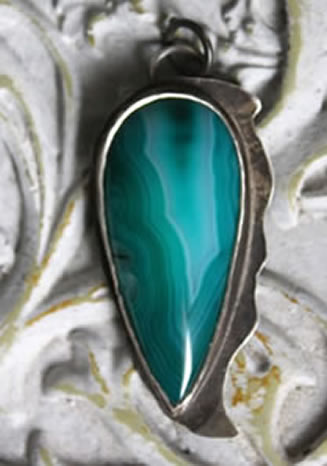
Psychology of the color blue
Blue, the color of the sky and ocean, evokes tranquility, infinity, and introspection. It is often associated with deep inner peace, promoting calm reflection and enhanced clarity. Blue is a soothing color that encourages meditation and inner balance. Through its varied shades, blue also symbolizes intuition, creativity, and open-mindedness.
Blue is also linked to trust and loyalty, qualities that are valued in both personal and professional relationships. Spaces decorated in blue tend to foster open and honest communication, making it a particularly favorable color for workplaces or relaxation areas. It is often used in meditation and healing spaces to create an atmosphere of calm and serenity. Blue is also associated with sleep, as it is commonly used in bedrooms to promote restful and restorative sleep.
However, certain shades of blue are also linked to darker emotions, such as sadness or melancholy, as suggested by the expression "feeling blue." This duality between calmness and sadness reflects the emotional complexity of blue, which is both comforting and introspective. Moreover, in some contexts, blue can symbolize coldness or even bad luck.
Lithotherapy and benefits of blue stones
Blue stones are widely used in lithotherapy for their calming and balancing properties. They are ideal for reducing stress and anxiety, creating a feeling of serenity and deep relaxation. Wearing them or using them during meditation can gradually release emotional tension, promoting better stress management.
These stones are also known for clearing the mind, dissipating confusion, and providing clearer insight into situations. They enhance decision-making by encouraging choices based on logic and wisdom rather than emotions. This clarifying power is particularly useful in moments of doubt or mental overload.
Associated with the throat chakra, blue stones facilitate the expression of thoughts and emotions. They help overcome communication blockages, promoting honest, fluid, and sincere speech. These stones also support those who seek to assert their inner truth or communicate more authentically.
On a spiritual level, these stones are linked to the third eye chakra, stimulating intuition and connection to higher realities. They enable access to a more subtle understanding of spiritual energies and open the way to deeper mystical experiences.
Lastly, by acting as shields against negative energies, blue stones protect the aura and strengthen personal energetic boundaries. They help maintain a purified spiritual and emotional environment conducive to personal and spiritual development.
The color blue in different cultures
In ancient Egypt, prized blue stones like lapis lazuli were symbols of the sky and immortality. Lapis lazuli, a deep blue semi-precious stone often flecked with golden veins resembling stars, was frequently used in funerary objects to guide the souls of pharaohs to eternity.
In China, blue symbolizes turmoil and death, but it is also used to evoke spirits or ghosts. This duality highlights the complex relationship some cultures have with blue, associating it with both spiritual and mortuary aspects.
In Turkey and Central Asia, blue is the color of mourning. This tradition dates back to the Ottoman Empire, where blue was used to symbolize death and grief.
This association of blue with mourning is also present in other cultures, such as in Iran and Afghanistan, where blue is often worn during funerals and mourning ceremonies.
In Buddhism, blue is the color of wisdom and inner peace. It is particularly associated with Akshobhya, the Buddha of unshakable awareness, representing tranquility in the face of worldly agitation. Buddhist monks also use this color in their meditations to awaken compassion and serenity.
In Hinduism, many deities are depicted with blue skin, such as Vishnu and Krishna. Blue symbolizes the role of guardian of the earth, particularly of water. Vishnu is often portrayed with blue skin to symbolize his role as the guardian of water, which is considered a source of life and purification in Hindu tradition.
Blue is also associated with divinity and spirituality in Hinduism, often used in temples and religious ceremonies to represent the divine presence.
For Jews, blue symbolizes the glory of God. Gazing upon this color aids meditation by offering a glimpse of the heavens and its purity. Blue holds significant importance in Jewish tradition, often used in rituals and religious ceremonies. For instance, blue is frequently used in synagogue decoration and ritual objects, as well as in garments and fabrics worn during religious ceremonies.
In the West, blue is often associated with tranquility, serenity, and peace. It is commonly used in interior design to create a calm and relaxing atmosphere.
For English speakers, blue often represents sadness. This can be attributed to common expressions such as "having the blues" or "feeling blue," which describe a state of melancholy or depression.
Examples of blue stones
Blue agate, blue lace agate, aquamarine, angelite, blue apatite, blue aragonite, blue aventurine, benitoite, blue chalcedony, blue calcite, Celestine, chrysocolla, covellite, dumortierite, hemimorphite, blue kyanite, lapis-lazuli, larimar, blue opal, blue quartz, blue sapphire, shattuckite, sodalite, turquoise, tanzanite…
Symbolism and properties of light blue stones
Essentials: Light blue stones, such as aquamarine and blue topaz, are often associated with clarity, communication, and inner peace. They can also symbolize serenity, freshness, and purity.
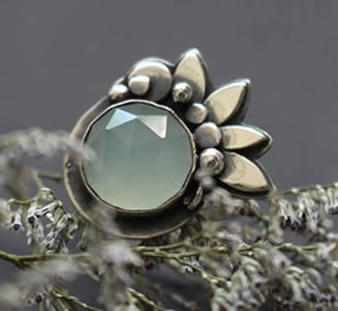
Psychology of light blue
Light blue, especially turquoise, is a color that evokes youth and communication. It symbolizes calm, health, confidence, and strength. This hue also reflects creativity and the ability to connect with others.
Turquoise is often associated with the sea and the sky, evoking a sense of freedom, openness, and lightness. Its soft, soothing tone is ideal for environments conducive to reflection and relaxation, providing much-needed mental respite in a world often burdened with stress. It is commonly used in interior design to create a calm and relaxing atmosphere. Its association with the sea and sky conveys freedom and openness, while its gentle and soothing hue fosters a space for rest and contemplation.
In color psychology, light blue is considered a calming color that helps reduce stress and promote relaxation. It is also associated with qualities such as creativity, communication, and self-confidence, making it a popular choice for workspaces and public environments.
Lithotherapy and benefits of light blue stones
Light blue stones are highly valued in lithotherapy for their soothing properties and ability to enhance communication. They are particularly beneficial for balancing the throat chakra, which is linked to personal expression and clear communication. Those who wear these stones often experience improved articulation of thoughts and emotions in a fluid, honest manner, while also becoming more receptive to others.
Light blue stones, such as aquamarine and chalcedony, have a calming effect on emotions, easing stress and worries. They are often used to calm emotional storms and provide mental clarity, allowing individuals to face challenges with serenity.
By fostering clear and smooth communication, these stones help reduce internal tensions and clarify thoughts. They are ideal for those seeking to step back from complex situations, think more clearly, and express their ideas with precision.
Light blue is also associated with light spirituality and intuitive awakening. It allows for a heightened sensitivity to subtle energies while instilling a sense of inner peace. These stones also aid meditation, encouraging peace and inner harmony, and enabling a deeper connection to spiritual dimensions.
By purifying the aura, these stones protect against negative influences while boosting self-confidence. Their subtle energy helps repel harmful energies gently, creating a shield of softness and peace.
Light blue in different cultures
In various cultures, light blue holds diverse symbolic meanings:
In Ancient Egypt, light blue, often represented by turquoise, was considered a protective talisman against evil. It was frequently used in sacred jewelry to ensure divine protection.
For many Indigenous peoples of the Americas, turquoise represented a connection to the spirits of nature, especially the sky and water. It also symbolized healing and protection.
In some Islamic traditions, light blue, particularly turquoise, is used in mosque architecture to represent the serenity of the sky and divine peace.
Light blue is a color associated with meditation and spiritual awakening, used in Buddhist practices to promote wisdom and inner peace.
In ancient China, light blue symbolized longevity and health and was often used in pottery and textiles to bring luck and protection.
Examples of light blue stones
Aquamarine, chalcedony, blue calcite, labradorite, blue topaz, blue tourmaline, turquoise…
Symbolism and properties of dark blue stones
Essentials: Dark blue stones, such as sapphire and blue spinel, are often associated with wisdom, truth, and loyalty. They also symbolize trust, stability, and depth, encouraging spiritual reflection and introspection.
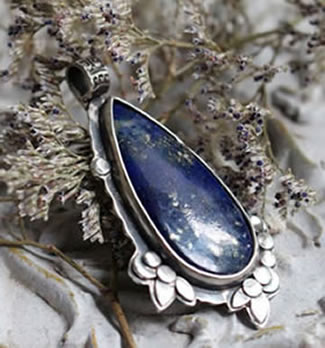
Psychology of dark blue
Dark blue, often likened to the starry night sky, evokes the celestial, the immaterial, and moderation. This deep shade is associated with the pursuit of truth, symbolizing inner communication and the quest for wisdom. It also represents self-control and perseverance.
This color inspires emotional stability, creating a sense of security and confidence. It is ideal for those seeking inner peace, mental discipline, and a better understanding of themselves. Dark blue invites deep reflection and a more balanced approach to complex situations.
In color psychology, dark blue is often regarded as a calming color that helps reduce stress and promotes deeper relaxation. It is also linked to qualities such as authentic communication, stability, self-confidence, and loyalty. These attributes make it a popular choice in professional spaces to encourage clear thinking, responsibility, and effective interpersonal relationships.
Lithotherapy and benefits of dark blue stones
Dark blue stones are highly valued in lithotherapy for their protective, wise, and harmonious properties. They are also known for their ability to promote mental and spiritual balance, providing support to those in search of inner truth and self-awareness.
Stones like sapphire and lapis lazuli are often used to stimulate intuition and develop discernment abilities. They enhance decision-making based on thoughtful reflection and help perceive the truth behind appearances. These stones assist in understanding deeper motivations and finding enlightened solutions to complex dilemmas.
These stones also work to calm tumultuous emotions, restoring emotional stability. They promote inner peace, and their soothing energy helps dissipate mental and physical tension, making them ideal for those going through periods of intense stress or mental confusion.
Dark blue stones act as powerful energetic shields, protecting against negative energies and unwanted external influences. They strengthen the aura and purify the energetic bodies, creating a space of spiritual serenity around oneself.
These stones are closely linked to the third eye chakra, stimulating intuitive perception and spiritual awakening. They help individuals better understand the subtle realities of existence, fostering a deeper connection with higher spiritual dimensions. In meditation, they are often used to enhance focus and spiritual elevation.
Dark blue in different cultures
In many cultures, dark blue holds deep significance related to spirituality, protection, and wisdom:
In ancient Egypt, dark blue lapis lazuli was revered as a symbol of power and divine protection. Pharaohs and priests used lapis lazuli to connect with the gods and protect against evil.
Among Native American tribes, dark blue was often associated with spiritual protection. Shamans used dark blue stones, such as sodalite, to enhance rituals and guide spirits in their healing quests.
In Tibetan Buddhism, dark blue is linked to the Buddha Akshobhya, symbolizing wisdom and unwavering consciousness. It represents the serenity that transcends worldly attachments and promotes spiritual awakening.
In Christian symbolism, dark blue, often associated with the Virgin Mary, is seen as a color of purity, truth, and faith. It is used to symbolize loyalty and faithfulness in medieval Christian art.
In the Islamic world, dark blue, particularly through ceramics adorned with lapis lazuli, was prized for decorating mosques, symbolizing peace and spiritual tranquility.
Examples of dark blue stones
Azurite, labradorite, lapis-lazuli, blue sapphire, sodalite, blue tourmaline…
Symbolism and properties of brown colors
Essentials: Brown stones, such as smoky quartz and tiger's eye, are often associated with stability, security, and grounding. They also symbolize strength, resilience, and practicality, providing a deep connection to the earth and nature.

Psychology of brown
Brown is intimately connected to the earth, representing stability, security, and solidity. It evokes images of deep roots that anchor and nourish, symbolizing fertility and the capacity for growth. It is a comforting, orderly color that invites simplicity and friendliness, providing a gentle warmth reminiscent of home and the tranquility of natural spaces.
While reassuring, brown can be perceived negatively if it is overly present, as it may suggest a repressed, rigid, or passive personality. In excess, it can evoke a sense of lack of energy or enthusiasm. However, brown often inspires solidity and reliability—qualities sought after to create a peaceful and comforting atmosphere.
In color psychology, brown is also associated with pragmatism and a sense of responsibility. It is a color that invites thoughtful reflection, concrete action, and grounding in reality, reminding us of the tangible and constant elements of life, symbolizing the strong roots one can rely on.
In decoration, brown is frequently used to create a warm, enveloping ambiance, evoking nature, wood, trees, and the earth itself.
Lithotherapy and benefits of brown stones
Brown stones are widely associated with grounding and protective virtues. In lithotherapy, they play a key role in stabilizing emotions, promoting grounding, and bringing balance between spiritual and physical dimensions. They are particularly appreciated for enhancing connection with the earth, allowing the wearer to feel secure and protected amidst daily challenges.
These stones also foster mental and emotional stability, helping to calm restless minds and bringing a sense of tranquility and inner peace. Their link to the earth element allows for better management of stress or uncertainty by instilling a sense of security.
Brown stones are also recognized for their ability to encourage perseverance and determination, supporting individuals in their endeavors by providing a solid foundation for moving forward. They enhance concentration, promote discipline, and stimulate pragmatic decision-making.
The color brown in different cultures
In many cultures, brown is perceived as a natural color linked to the earth and life.
For Native Americans, for example, this color is often associated with fertility, motherhood, and the protection of the nurturing earth. Ritual ceremonies may include the use of brown elements to honor Mother Earth, symbolizing wisdom and abundant resources.
In Western societies, brown is generally associated with hard work, simplicity, and resilience. It symbolizes everyday life, productivity, and endurance. In modern design, brown is appreciated for its calming and natural properties, often chosen to create environments conducive to relaxation and contemplation.
In Africa, brown is sometimes linked to the earth and ancestors, embodying the connection between generations and the continuity of traditions. It is seen as a color of spiritual connection with the forces of nature, reinforcing the idea of solidity and permanence in collective and family life.
In Buddhist symbolism, brown can be perceived as a color of humility and a return to the essentials. It represents sobriety, asceticism, and renunciation of material goods in favor of a simple and grounded spiritual life.
Examples of brown stones
Brown agate, aragonite, axinite, petrified wood, bronzite, chiastolite, tiger eye, smoky quartz, stromatolithe, brown tourmaline…
Symbolism and properties of golden stones
Essentials: Golden stones, such as citrine and imperial topaz, are often associated with wealth, prosperity, and abundance. They can also symbolize self-confidence, success, and mental clarity.
Psychology of gold
The golden color, reminiscent of the sun, symbolizes spiritual wealth, illumination, radiance, prosperity, opulence, luxury, good health, and optimism. It is often associated with qualities such as wealth, success, and abundance. Gold reflects a radiant energy linked to spiritual awakening and divine light. In interior design, gold adds a touch of elegance and sophistication, creating an atmosphere of warmth and luxury.
Gold has virtually no negative connotations, except when associated with greed or excess.
In color psychology, gold is considered a stimulating color that can boost self-confidence and enhance motivation. It is also linked to creativity and mental clarity, making it ideal for work environments where dynamic energy is desired.
Crystal healing and benefits of golden stones
Golden stones, such as citrine and pyrite, are widely recognized in crystal healing for their energetic properties related to abundance and prosperity. They promote personal and professional success while providing mental clarity that aids in making informed decisions. These stones are often used to enhance self-confidence and attract success in various endeavors.
Directly linked to the solar plexus chakra, these stones are ideal for improving self-esteem and stimulating motivation. They encourage independence, determination, and perseverance, helping to overcome personal obstacles and achieve goals. Additionally, they are reputed to strengthen the immune system and balance digestive issues, thereby enhancing vital energy.
Golden stones also act as a protective shield, dissipating negativity and harmful energies. Their brilliance symbolizes light that dispels darkness, creating a protective barrier while fostering harmony and balance.
The color gold in different cultures
In ancient Egypt, gold was the color associated with the gods and immortality. Statues of pharaohs and gods were often covered in gold to symbolize their divinity and connection to the sun, particularly the sun god Ra.
During the Middle Ages in Europe, gold was a color reserved for royalty and religious figures, symbolizing not only temporal power but also divine grace. Crowns, thrones, and liturgical objects were often adorned with gold to evoke wealth and divine protection.
In Chinese culture, gold is closely linked to the emperor and immortality. It is also associated with Yang energy, representing light, warmth, and dynamism—crucial elements in energy balance.
In Hinduism and Buddhism, gold symbolizes purity and spiritual knowledge. Buddha statues and temples are often gilded to evoke divine light and spiritual enlightenment, representing the path to soul liberation.
In Native American cultures, gold is often associated with the earth and fertility. Used in art and craftsmanship, it symbolizes a deep connection with nature, life, and the earth's generosity.
Examples of golden stones
Citrine, pyrite, imperial topaz, gold, golden calcite, tiger's eye, heliodor, golden amber, golden rutilated quartz, golden fluorite, etc.
Symbolism and properties of green color stones
Essentials: Green stones, such as emeralds and peridots, are often associated with nature, growth, and renewal. They also symbolize prosperity, abundance, and harmony, connected to emotional and physical balance.
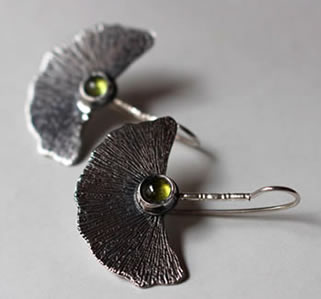
Psychology of green
Green symbolizes life in its cyclical form, particularly the growth of plants. As the color of nature, it evokes fertility, regeneration, and vital energy. Green embodies notions of youth, renewal, and spontaneity, creating a powerful connection to learning and rebirth. It is the color of balance, bringing a sense of serenity and well-being, and promoting calmness, gentleness, and harmony in the environment.
This color is also imbued with hope and prosperity, suggesting continuous growth and abundance. Olive green, in particular, is a shade traditionally associated with peace and reconciliation. It is often used in meditative or spiritual practices to foster a state of inner balance.
However, some shades of green can carry negative connotations. Dark green is often linked to excessive ambition, greed, and jealousy. Additionally, yellow-green can symbolize illness, cowardice, and discord. This duality in the symbolism of green is also seen in its association with inexperience and naivety, connected to the image of unripe fruits. These various shades offer a rich range of meanings, from abundance and vitality to ambition or deception.
In interior design, green is a highly sought-after color for creating a soothing, refreshing, and natural ambiance, evoking the tranquility of outdoor spaces.
Lithotherapy and benefits of green stones
In lithotherapy, green stones are often linked to the heart chakra, the center of unconditional love and emotional healing. These stones have the capacity to strengthen emotional balance and inner peace while promoting physical well-being. They are also renowned for bringing prosperity, luck, and abundance into the lives of those who use them.
Their association with growth and renewal makes them particularly beneficial for those going through periods of personal transformation. They encourage embracing change with serenity while stimulating physical and mental vitality. Additionally, green stones are known for promoting healing, whether on a physical level by assisting cell regeneration or on an emotional level by helping to overcome heart wounds and releasing stagnant energies.
The color green in different cultures
In Chinese culture, green is associated with the wood element, representing growth, vitality, and renewal. It is also linked to the direction of the East, often considered the starting point of birth and renewal. Green is commonly used in interior decoration to attract luck and ward off evil spirits. House doors are often painted green to protect residents and encourage prosperity.
In Irish and English folklore, green is associated with witchcraft, fairies, and leprechauns. Celtic culture links this color to nature, fertility, and magic. Irish legends speak of fairies living in lush forests, symbolizing the deep connection between green and natural forces. Fairies and leprechauns are often depicted wearing green clothing. Green is also the national color of Ireland, frequently celebrated during St. Patrick's Day, tying this color to identity and luck.
In Islamic religion, green is a sacred color associated with nature, fertility, and life. It often features in the decorations of mosques and holy places, symbolizing peace and spirituality. Green is also linked to the banner of the Prophet Muhammad, represented with a green background and Arabic inscriptions. In the Quran, the chosen ones in paradise are clothed in green silk, reinforcing this color's association with nature, abundance, and eternal life. This association may originate from the connection of the color with nature and abundance, referencing the oasis amidst the desert.
In ancient Mesoamerican civilizations, such as the Maya and the Aztecs, green was an extremely precious color, often associated with royalty and gods. The Maya linked green to jade, a sacred stone representing life, fertility, and eternity. This color was also connected to water and vegetation, crucial elements for these agrarian civilizations. Beyond this natural symbolism, green also represented power and wealth, and only elite members could afford to wear or possess green objects. Among the Aztecs, the color green, associated with Quetzalcoatl, the feathered serpent god, also signified divine wisdom and immortality. Thus, the color green held both spiritual significance and symbolized the fertility of the earth and the cyclical regeneration of nature.
In medieval Europe, the color green had an ambivalent connotation. On one hand, it symbolized nature, fertility, and youth. It was associated with life and growth, particularly through figures like Robin Hood, a symbol of freedom and justice in the forest. On the other hand, green could also carry negative associations. Specifically, it was sometimes seen as an unstable and even dangerous color due to its connection with poison and disease. Green dyes were also difficult to produce and stabilize at that time, reinforcing the idea of its "capricious" nature. This explains why green was often assigned to malevolent characters in medieval literature, particularly witches and figures of cunning.
Examples of green stones
Moss agate, amazonite, aventurine, green calcite, green chlorite, chrysocolla, chrysoprase, diopside, emerald, epidote, fuschite, heliotrope, jadeite, nephrite jade, malachite, moldavite, peridot, prehnite, prase quartz, green sardonyx, seraphinite, serpentine, green tourmaline, tsavorite, vesuvianite…
Symbolism and properties of grey color stones
Essential: Gray stones, such as moonstones and labradorites, are often associated with intuition, mystery, and transformation. They can also symbolize balance, protection, and inner strength.
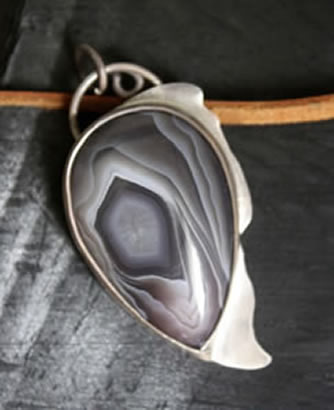
Psychology of grey
Gray, the color of nuance and compromise, evokes the balance between black and white. It symbolizes security, maturity, reliability, wisdom, knowledge, and responsibility. This color is associated with the wisdom and dignity acquired over time, reminiscent of the grey hair of the elderly. Since the 1930s, grey has also become the color of many business suits.
However, grey can also be interpreted as a lack, neither white nor black, nor colorful.
In color psychology, grey is often associated with neutrality, reserve, and discretion. It is considered a calm and soothing color that can help reduce stress and promote concentration. Gray is also linked to stability and security, as it evokes solidity and reliability. On the other hand, grey can also be perceived as a dull and boring color, lacking vitality and dynamism. In psychology, grey is often used to represent neutrality and objectivity, as it is viewed as a color that elicits neither strong emotions nor reactions.
Finally, grey is frequently used in design and interior decoration to create an elegant and sophisticated atmosphere, as it is regarded as a timeless and classic color.
Lithotherapy and benefits of grey stones
In lithotherapy, grey stones are often associated with stabilizing and balancing energies. They help calm the mind, soothe emotions, and recenter the individual. These stones are reputed to provide a sense of security and protection, aiding individuals during periods of doubt or personal transformation. Their neutral nature fosters deep reflection, introspection, and harmonization of mental and spiritual energies. They are also recognized for encouraging balanced decision-making by providing a clear perspective on situations. Their subtle hue helps dissipate negative energies while promoting emotional and mental stability.
The color grey in different cultures
For Native Americans, grey symbolizes friendship, representing harmony and balance between different tribes and nations. This neutral and calming color is associated with cooperation and solidarity, as it highlights the need to work together to overcome challenges and obstacles. Gray is also linked to wisdom and maturity, evoking the ability to step back and see things as a whole. Finally, grey is often used in Native American ceremonies and rituals to symbolize unity and brotherhood among community members.
In Hinduism, grey is a sacred color, much like silver. It represents the smoke of incense rising to the sky, carrying human prayers. This color is often associated with meditation and spirituality, evoking tranquility and serenity of the mind. Gray is also linked to purification and the release of negative energies, symbolizing the ability to let go of thoughts and emotions that hold us back. Lastly, grey is commonly used in Hindu temples and places of worship to decorate altars and statues of deities, as it is seen as a color that brings peace and protection.
In the West, grey is often associated with boredom, depression, melancholy, and sadness, as it evokes a dull and dreary atmosphere, devoid of vitality and dynamism. This neutral and muted hue can symbolize a lack of emotion or interest, and it is sometimes perceived as an absence of color or life. Gray can also remind one of rainy and gloomy days, where the sky is covered with grey clouds, and the atmosphere is morose. As an intermediate color between black and white, grey can also represent a state of indecision or uncertainty, where things are neither clear nor decisive.
In China, grey is often viewed as an intermediate color representing balance between yin and yang, the opposing forces of the universe. It symbolizes moderation, neutrality, and harmony in change, as it lies between white and black. This color is seen as a hue of transition and transformation.
In Japan, grey (or "nezumi-iro," the color of the rat) is associated with simplicity, humility, and elegance. In Noh theater, grey costumes evoke calmness and tranquility of mind, and the color is also linked to discipline and self-control, particularly among samurai.
Examples of grey stones
Botswana agate, hematite, labradorite, snowflake obsidian, galena, pyrite, grey moonstone, smoky quartz, gabbro, hawk's eye...
Symbolism and properties of orange stones
Essentials: Orange stones, such as fire opals and carnelian, are often associated with creativity, passion, and enthusiasm. They can also symbolize warmth, vitality, and courage.
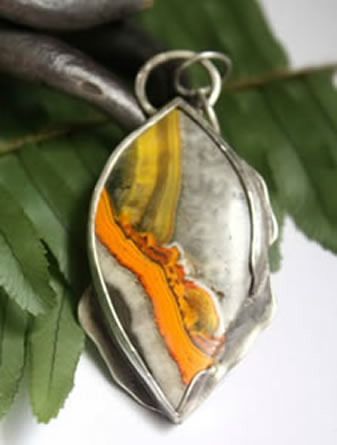
Psychology of orange
Between red, symbolizing energy, and yellow, representing flourishing, orange is a breath of life. It is the color of rebirth, renewal, and balance. Orange embodies joy, confidence, enthusiasm, and fun. It signifies vitality and endurance. Its energy is similar to the fiery warmth of red but softer and less explosive.
Orange is the color of material pleasure, sociability, enthusiasm, friendship, spontaneity, and relational interactions. It evokes exploration, curiosity, and encourages creativity. Orange also represents awakening and desire (for life, food, sexuality, etc.).
Additionally, orange is perceived as stimulating for both the mind and body, promoting positive emotions such as optimism and motivation. It is often used in color psychology to combat depression and mental fatigue. This color is widely employed in marketing to evoke friendliness and accessibility, particularly in food commerce and leisure.
However, orange can also have negative connotations in certain cultures or contexts. This bright and energetic hue may be seen as unstable, impulsive, immature, or even aggressive. Its vibrancy can be uncomfortable or overwhelming in large quantities, and its brightness may evoke excessive agitation or eccentricity. Furthermore, orange can be associated with warnings or danger signals due to its visibility and brightness.
Lithotherapy and benefits of orange stones
Orange stones are recognized for their numerous virtues in lithotherapy. They are often associated with powerful effects on emotional and physical levels.
These stones are particularly used to stimulate imagination and awaken creativity, making them ideal for artists or anyone seeking to unlock their creative potential.
They promote emotional balance and provide a sense of warmth and emotional stability. They are known for their ability to alleviate mental fatigue, depression, and melancholy.
Physically, orange stones enhance vitality and endurance. They help stimulate the immune system and bring energy, enthusiasm, and motivation during periods of fatigue.
The color orange in different cultures
For Hindus, orange represents the second chakra, known as Swadhisthana, located in the lower abdomen. This chakra is associated with creativity, vitality, and sexuality. Orange is therefore used in clothing and decorations to symbolize the activation of this chakra and the balance of its energies. It is also considered a sacred color, representing purifying fire, synonymous with spiritual liberation and inner transformation. Wearing orange clothing is often associated with renouncing material desires and seeking spiritual truth.
Buddhist monks also wear orange, symbolizing Gautama Buddha’s renunciation of worldly life. For them, orange symbolizes purity, as its color is close to that of gold. Wearing orange serves as a constant reminder of their commitment to spirituality and the pursuit of truth.
In China, according to Confucianism, orange is the color of transformation. Red represents happiness and power, fire and sensuality. Yellow evokes perfection, nobility, light, and spirituality. Orange is the compromise between these two complementary elements, hence symbolizing transformation. It is often used in wedding ceremonies to represent the transition from singlehood to marriage. It is also employed in mourning ceremonies to symbolize the passage from life to death. Similar to India, orange is color-linked to saffron, the finest and most expensive dye.
In the West, orange is often associated with autumn, especially during Halloween festivities. It represents change, the cycle of life, and the end of a season. Native American cultures associate orange with communication with the spiritual world and the unity between the material and spiritual realms.
Examples of orange stones
Orange amber, bumblebee jasper, orange calcite, carnelian, orange disthene, fire opal, sunstone, spessartine, orange imperial topaz…
Symbolism and properties of pink stones
Essentials: Pink stones, such as rose quartz and pink tourmalines, are often associated with love, compassion, and emotional healing. They can also symbolize sweetness, kindness, and support. These stones promote emotional openness and help to calm internal tensions.
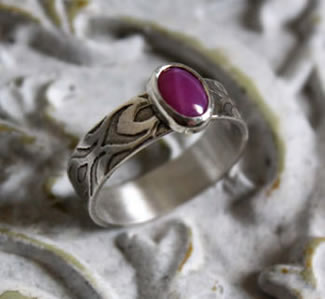
Psychology of pink
Pink, the emblematic color of love and friendship, also evokes controlled passion, romance, and subtle seduction. This hue, born from the union of vibrant red and soothing white, embodies sweetness, tenderness, acceptance, compassion, and loyalty. It symbolizes politeness, sensitivity, and the ability to temper aggression. Pink is often associated with a feeling of emotional safety and protection, creating a cocoon that invites gentle introspection.
However, pink can also be linked to naivety, excessive sentimentality, or a certain superficiality. When overused, it may be perceived as immaterial or detached from reality. In some contexts, pink could suggest a flight from responsibilities or a reluctance to confront the more pragmatic challenges of life.
Pink is frequently used in environments where a relaxing and wellness-oriented atmosphere is desired, such as bedrooms or meditation rooms. It promotes a calm environment conducive to emotional healing. Additionally, this color is often associated with femininity and youth, and is commonly seen in beauty products and women's clothing.
In psychology, pink is considered a soothing color that can help calm internal tensions and facilitate the healing of emotional wounds. Some studies even suggest that pink can reduce stress and aggression in emotionally charged environments.
Lithotherapy and benefits of pink stones
Pink stones are widely recognized in lithotherapy for their beneficial effects on emotional and spiritual levels.
Pink stones are particularly known for helping to heal heart wounds. They promote self-love and acceptance of past events.
These stones encourage openness and gentleness. They help balance emotions, strengthen emotional bonds, and cultivate compassion.
Pink stones, especially rose quartz, are known for their ability to ease anxiety and bring a sense of inner peace.
These stones encourage a deep connection with oneself and others, allowing for a smoother exchange of emotional energy.
The color pink in different cultures
In Japan, pink is closely associated with spring due to the blooming of cherry blossoms that paint the landscape in pale pink. This period is celebrated with hanami, the tradition of cherry blossom viewing. The color pink symbolizes the ephemeral beauty of these flowers, which represent life, death, and renewal. In contrast, in Europe and the United States, green is traditionally chosen to symbolize this season. However, pink is increasingly used to evoke the lightness of spring and the fragility of life.
In Chinese culture, pink is intimately linked to femininity, softness, and beauty. This delicate hue also evokes harmony and balance in human relationships. Traditionally, pink is widely used in wedding ceremonies to symbolize deep love and future marital happiness. It represents the purity and sincerity of feelings between spouses while embodying the hope for a lasting and fulfilling union.
In Indian culture, pink is often associated with happiness, prosperity, and joy. This vibrant hue also evokes passion and the energy of life. Traditionally, pink is used in religious ceremonies to symbolize purity and devotion. It represents the deep spiritual connection between the individual and the divine, often used in offerings and rituals to honor gods and goddesses.
In African culture, pink is often associated with healing, protection, and spirituality. This soft and soothing color is considered a symbol of renewal and regeneration. Traditionally, pink is used in healing rituals to bring peace and tranquility. It is regarded as a color that can help balance energies and promote physical and emotional healing.
In the West, pink is primarily perceived as a color associated with femininity, tenderness, and innocence. It is often used to evoke sweetness, delicacy, and romantic love. Pink is commonly linked to youth, particularly through fashion and products aimed at young girls. However, over time, this perception has evolved, and the color is also adopted in more varied contexts, including men's fashion and cultural movements that challenge gender stereotypes. Moreover, pink is sometimes associated with excessive sentimentality or naivety, although these connotations tend to fade over time, allowing for a more diverse use of the color in art and design.
Examples of pink stones
Chalcedony, dandurite, pink fluorite, pink halite, kunzite, morganite, pink opal, petalite, pink quartz, rhodochrosite, rhodolite, rhodonite, pink sapphire, spinel, pink topaz, pink tourmaline…
Symbolism and properties of purple stones
Essentials: Purple stones, such as amethysts and tanzanites, are often associated with spirituality, intuition, and mysticism. They can also symbolize royalty, luxury, and wisdom.

Psychology of purple
Purple, this enchanting and mysterious color, is much more than just a shade. It embodies wisdom, magic, spirituality, and royalty, evoking a world of contemplation and enigma. It is the color of clear minds and souls seeking spiritual fulfillment, bringing peace of mind and sound judgment.
Purple derives its strength from the duality between dynamic red and soothing blue, thus balancing energy and serenity. This harmony of colors symbolizes the equilibrium between passion and peace, strength and gentleness. It is a hue frequently used in creative and meditative contexts, promoting introspection while stimulating imagination and innovation.
Historically viewed as a negative hue associated with deceit, betrayal, sadness, penitence, vanity, and affliction, purple has been rehabilitated by science as a legitimate color in its own right. Once regarded as a variant of black, it was more connected to mourning. While there still exists some association of purple with jealousy, it is now also linked to creativity, intuition, and transformation.
Lithotherapy and benefits of purple stones
Purple stones are prized for their calming effects on the mind and emotions. They balance emotions and are ideal for fostering inner serenity. In meditation, they strengthen spiritual connection, stimulate intuition, and help clarify the mind. In lithotherapy, they are commonly used to soothe fears, relieve stress, and encourage emotional healing. These stones, particularly amethyst, are also recognized for promoting imagination and creative inspiration.
Purple is also linked to the crown chakra (Sahasrara) in Western spirituality, representing pure consciousness, connection to the divine, and spiritual awakening. It is often used to enhance meditation and spiritual elevation.
The color purple in different cultures
In Japanese culture, purple is often associated with nobility and wealth. This color, called "murasaki" in Japanese, was historically reserved for the imperial family and nobles. It symbolized prestige and high social status. Kimonos and ceremonial garments worn by members of the imperial court were often adorned with purple patterns or dyes, reflecting their elevated rank. Alongside this association with nobility, purple is also considered a mourning color in Japan. It is often worn at funerals and used in floral arrangements to express respect and sorrow.
In African culture, purple is often associated with royalty and spirituality. This color, derived from natural pigments like logwood, was historically used to dye the garments of kings and queens, as well as to decorate palaces and temples. Purple symbolized power, wisdom, and connection to the divine. Alongside this association with royalty and spirituality, purple is also a mourning color in many African cultures. It is worn at funerals and used in rituals to honor the deceased and express grief.
In ancient Egypt, purple was a rare and precious color, often associated with royalty and high society. It also symbolized spirituality and connection with the gods, as purple dyes were difficult to produce and very costly, making it a color reserved for the elite.
In Europe, purple is synonymous with luxury and refinement. It is often used to highlight precious objects such as jewelry boxes or wine bottles, emphasizing their exceptional character. This color evokes opulence and sophistication, adding a touch of elegance to anything it touches. Whether in the reception halls of royal palaces or in high-fashion boutiques, purple symbolizes prestige and distinction. Its use in interior decoration and table arts signifies good taste and refinement. In sum, purple is a color that embodies excellence and the European art of living.
In Native American culture, purple is associated with healing and purification. This color, often derived from natural pigments like indigo, was used in healing and purification rituals. Shamans and healers utilized purple to balance energies and promote physical and spiritual healing.
Examples of purple stones
Amethyst, charoite, cordierite, purple fluorite, lepidolite, purpurite, lavender quartz, stichtite, sugilite…
Symbolism and properties of red colored stones
Essentials: Red stones, such as rubies and garnets, are often associated with passion, love, and vitality. They can also symbolize courage, strength, and determination.
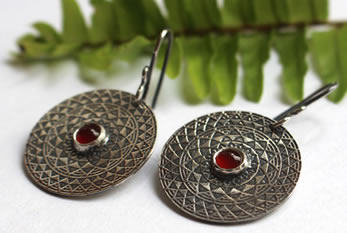
Psychology of red
Red, the color of blood and fire, evokes energy, dynamism, courage, strength, will, determination, and audacity. It inspires action rather than reflection, symbolizing passion, love, sexuality, and life. In color psychology, red is often perceived as a powerful energy stimulator, creating feelings of urgency, impulse, or motivation. It embodies perseverance and the need to excel.
However, this warm color also carries negative connotations, such as anger, impatience, lack of thought, and danger. Red connects us to our primitive physical and emotional instincts, evoking survival and self-preservation. Its intensity can sometimes feel aggressive or overwhelming, particularly when used in large amounts, symbolizing uncontrolled emotions like rage or jealousy.
In the West, red is frequently associated with love and passion. It is the color of roses given on Valentine's Day and is often used in advertisements or products evoking sensuality. However, red can also signal urgency and danger, as seen in traffic lights or alerts, making it an ambivalent color that is both attractive and intimidating.
Red is often used in design and interior decoration to create an energetic and stimulating atmosphere, as it is considered a color that brings vitality and passion. It is also associated with warmth and friendliness, reminiscent of fire and sunlight.
Lithotherapy and benefits of red stones
In lithotherapy, red stones are renowned for their ability to stimulate vital and physical energy. They are associated with grounding and protection, reinforcing will, perseverance, and courage. Connected to the root chakra, they help stabilize emotions, providing a sense of security and connection to the earth. Red, as the color of life, is also linked to physical vitality: red stones can help energize the body, improve blood circulation, and promote better oxygenation of cells. Emotionally, these stones assist in releasing blockages related to fear and anger, allowing for better emotional control in stressful situations.
The color red in different cultures
In China, red is associated with prosperity and joy, symbolizing fire and reminding of courage, loyalty, honor, success, fortune, fertility, happiness, passion, and summer. Traditionally linked to marriage, brides wear red garments, and valuable gifts are often wrapped in red paper. Red is also used in interior decoration to attract luck and ward off evil spirits, often by painting front doors in this color. Red front doors are commonly painted to protect the family and bring prosperity.
Red is also significant due to its association with the Chinese dragon, a symbol of power, strength, and good fortune. Red dragons appear in celebrations and festivals to bring luck and prosperity, especially during Chinese New Year, where red clothing and decorations are ubiquitous to attract good fortune and drive away evil spirits.
In Japan, red symbolizes the hero. It is associated with strength, courage, and determination. It is often used in flags, military uniforms, and national symbols to represent the bravery and heroism of warriors and samurai.
In India, red is the traditional color of brides' dresses and married women, symbolizing purity, fertility, wealth, and beauty. Red is also sacred in Indian culture, linked to the goddess Lakshmi, the embodiment of prosperity, fortune, and beauty.
In Africa, the perception of red varies: in Central Africa, it is often associated with life and health, while in other parts of the continent, it may be linked to death and mourning. In these cultures, red is used for funerals and memorial ceremonies, symbolizing the transition from life to death. This color, associated with blood and pain, expresses grief and loss.
Examples of red stones
Andesine, red calcite, cinnabar, red coral, carnelian, eudialyte, garnet, heliotrope, hematite, red jasper, bull’s eye, ruby, spinel, vanadinite…
Symbolism and properties of silver color stones
Essentials: Silver stones, such as argentite and galena, are often associated with reflection, intuition, and wisdom. They embody clarity, purity, and protection. In lithotherapy, they promote spiritual connections, support the development of intuition, and help shield against negative influences.
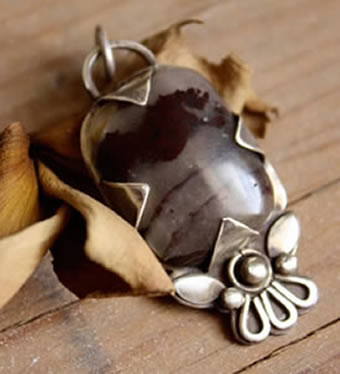
Psychology of silver color
The silver color, with its subtle metallic sheen, embodies both material and spiritual dimensions. It symbolizes inner wealth, hidden power, and wisdom gained through experience.
As a symbol of transformation and progress, silver is often linked to the moon and its changing cycles, reminding us that personal transformation occurs in stages, through a movement of growth and renewal.
Lithotherapy and benefits of silver color
Silver stones stand out for their ability to amplify intuition and stimulate reflection. Their energy acts like a mirror, allowing for a deeper connection to one’s inner truths while repelling negative energies. This "energetic mirror" function is tied to their association with wisdom and mental clarity, facilitating informed decision-making.
As a color of balance, silver combines the protective properties of metal with the ethereal purity of moonlight. This duality is especially beneficial for meditation, introspection, and spiritual practices aimed at revealing hidden truths or answers beyond the material plane. Silver stones also protect against negative external influences, purify emotions, and bring soothing inner peace.
Although silver is not associated with a specific chakra, its reflective and protective qualities help harmonize the entire energy system. It is also connected to the crown chakra (Sahasrara), facilitating connection with the divine and higher spiritual planes.
Silver color in different cultures
In Hinduism, the silver color is sacred, much like gray. It represents the color of incense smoke that rises to the sky to carry human prayers.
In Asia, particularly in Korea, China, and Japan, the term "river of silver" is used to refer to the Milky Way, symbolizing mystery, infinity, and continuity.
In Japanese culture, silver is associated with the moon, often represented as a silver disc. The moon symbolizes purity and serenity, and it is frequently linked to beauty and femininity.
In China, silver is often associated with wealth and prosperity. In Chinese tradition, silver is commonly given as a gift for weddings and birthdays, as it is seen as a symbol of good fortune and success.
In the West, silver is often associated with wealth and luxury. It is frequently used in interior decoration to add a touch of elegance and sophistication to a space.
In England, in heraldry, the silver color represents brightness, purity, virtue, or innocence.
Examples of silver stones
silver, bismuth, galena, hematite, magnetite, marcasite, pyrite, pyrolusite…
Symbolism and properties of white or transparent stones
Essentials: White stones, such as diamonds and pearls, are universal symbols of purity, innocence, and perfection. In lithotherapy, they provide clarity, truth, and protection, helping to elevate consciousness and promote spiritual connection.
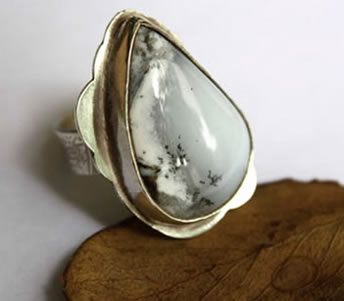
Psychology of white and transparent colors
White, the color of purity and light, embodies knowledge, wisdom, spirituality, and peace, radiating a softness and cleanliness that soothe the soul. This color also evokes compassion, wholeness, innocence, kindness, and truth, symbolizing completion and an openness to new horizons.
While white is associated with positive qualities like innocence and simplicity, it also has more ambiguous aspects. In some cultures, it is linked to death and the transition to the afterlife (the pallor of death, ghosts, and aging). This reflects the duality of white, which is synonymous with both beginnings and endings, yet always carries wisdom and transformation. White hair, a sign of wisdom and maturity, is also a symbol of old age. Finally, white can evoke absence, emptiness, and solitude, as it is often associated with purity and clarity.
Psychologically, white is often seen as a calming color that promotes tranquility and relaxation. Used in healing or meditation environments, it creates a serene atmosphere conducive to reflection and introspection.
Lithotherapy and benefits of white and transparent stones
In lithotherapy, white or transparent stones are primarily used to purify the aura and harmonize the body’s energies. They act as purifying agents, removing energetic blockages and negative energies. Their ability to clarify the mind makes them ideal for those seeking to dispel mental confusion and bring discernment and clarity to decision-making.
These stones also promote a profound sense of inner peace and emotional tranquility. They are often used to reduce stress and encourage a state of relaxation, particularly in meditation or spiritual practices. Associated with the crown chakra, they facilitate access to higher levels of consciousness and spiritual wisdom.
The pure, luminous shine of white or transparent stones plays a harmonizing role, balancing the chakras and energies of the body. This harmonization creates an overall sense of well-being, allowing individuals to reconnect with their spiritual essence while releasing emotional and mental tension.
White and transparent colors in different cultures
White holds deep and varied meanings across many cultures.
In China, white is associated with death and mourning. Death is viewed as a transition to new life, a rebirth. Thus, white evokes the purity and clarity of this new stage. It also symbolizes respect and tribute to the deceased, as well as the peace and serenity that accompany the passage to the beyond.
In the Japanese religion of Shinto, a white gravel area marks the entrance to sacred places dedicated to spirits descended from the heavens. This trend later extended to Zen Buddhist temples, where white sand or gravel gardens, known as "kare-sansui" or "dry gardens," are often found to aid meditation.
In Hinduism, white is often linked to purity and spirituality, frequently worn during religious ceremonies and rituals.
In Africa, white is also associated with death and mourning.
In the West, white is often associated with purity and innocence. It is commonly used in weddings to symbolize purity and simplicity.
In Christianity, white is frequently used for priests' and saints' garments, as well as for baptism and wedding ceremonies.
Examples of white or transparent stones
White agate, white aragonite, white chalcedony, rock crystal, diamond, howlite, white kunzite, white opal, opalite, milky quartz, white sapphire, scolecite, white selenite, white topaz, ulexite….
Symbolism and properties of yellow stones
Essential: Yellow stones, such as citrines and yellow sapphires, are often associated with happiness, joy, and optimism. They also symbolize intellect, creativity, and illumination, bringing warmth and positive energy.
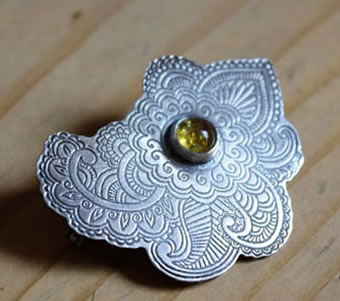
Psychology of yellow
Yellow is the color of the sun, warmth, and gold. It symbolizes energy, creation, wisdom, joy, happiness, flourishing, dynamism, bliss, intelligence, amusement, and self-esteem. The idea of light associated with the color yellow is what represents intelligence and wisdom.
However, yellow also has its negative aspects, evoking betrayal, duplicity, and jealousy. These connotations can be attributed to the changing nature of yellow, which can shift from a warm, welcoming hue to a cooler, more deceptive shade. Indeed, yellow can be associated with trickery and duplicity due to its ability to blend into its environment and camouflage itself while maintaining a bright, attractive appearance. Similarly, jealousy can be linked to yellow for its ability to attract attention and provoke envy in others. Betrayal can also be associated with yellow due to its capacity to change color and transform while still appearing luminous and appealing. Additionally, yellow may be perceived as an aggressive and intrusive color because of its brightness, which can be overwhelming in large quantities.
Psychologically, yellow is often used to represent youth, freshness, and innocence, reminding us of the colors of flowers and fruits. It is a color that stimulates the intellect and promotes optimism. In design and decoration, it creates a warm and inviting atmosphere, bringing positive energy and a sense of well-being.
Lithotherapy and the benefits of yellow stones
In lithotherapy, yellow stones are renowned for their energizing and revitalizing effects. They act like inner rays of sunshine, dissipating negative energies and boosting self-esteem. Stones of this color promote mental clarity, creativity, and stimulate intellectual abilities. They are often used to enhance motivation, self-confidence, and optimism. Yellow stones are also known for balancing emotions, alleviating stress, and promoting a general sense of well-being. As symbols of prosperity and success, they help overcome obstacles and attract energies of growth and personal achievement.
The color yellow in different cultures
In Asia, yellow symbolizes power, sovereignty, and aristocracy, a position held by purple-red in the West. This color is often associated with wealth, prosperity, and good luck, as it resembles the color of gold, a highly valued metal in Asian culture. Yellow is also linked to royalty and nobility, as it evokes the colors of clothing and ornaments worn by emperors and imperial family members.
In China, yellow was reserved for the emperor. The first emperor is called the Yellow Emperor. Yellow, red, and green are masculine colors, in contrast to black and white, which are considered feminine. This leads to the representation of the masculine yang in yellow complementing the yin in black. This association between yellow and masculinity is deeply rooted in Chinese culture, where yellow is often used to symbolize strength, power, and virility. In fact, yellow is the color of the emperor, regarded as the supreme leader and protector of the Chinese people.
In Buddhism or Hinduism, yellow is a significant color symbolizing saffron (a very expensive product) and renunciation. The shades found on clothing range from yellow to orange. Yellow is a sacred color in these religious traditions, as it is associated with spirituality, meditation, and the pursuit of enlightenment. Yellow is often used in temples and places of worship to decorate altars and statues of deities, as it is considered a color that brings peace and serenity.
In Central and South America, yellow is a favored and highly positive color. It evokes the sun, a source of life, as well as gold and corn, a staple food. In these cultures, it symbolizes prosperity and fertility and is often associated with rituals related to life and abundance.
In Islam, yellow evokes gold and wisdom. This color is often linked to wealth, prosperity, and good fortune, as it resembles the color of gold, a highly valued metal in Islamic culture. Yellow is also related to wisdom and knowledge, as it evokes sunlight, which is often used as a metaphor for wisdom and understanding.
In Polynesia, yellow is the color of the sacred, symbolizing the gods and spiritual connection with nature. It represents spirituality, divine purity, and harmony with higher forces.
In ancient Egypt, yellow was associated with gold, a symbol of eternity and immortality. The funerary masks of pharaohs were often gilded, representing the flesh of the gods and their eternal power.
In medieval Europe, yellow had ambivalent connotations. It symbolized both wealth and nobility when it represented gold, but also betrayal and envy, particularly through negative portrayals of Judas.
Examples of yellow stones
Yellow amber, yellow calcite, honey calcite, chalcopyrite, chrysoberyl, citrine, yellow fluorite, yellow jasper, cat’s eye, tiger eye, lemon quartz, yellow sapphire, sulfur, titanite, imperial topaze…
To learn more about color symbolism, we recommend you the following books:



